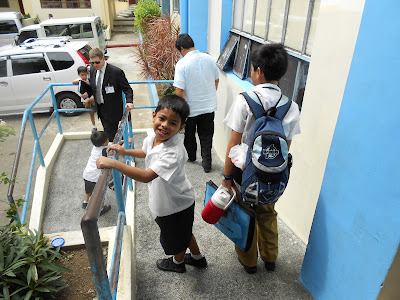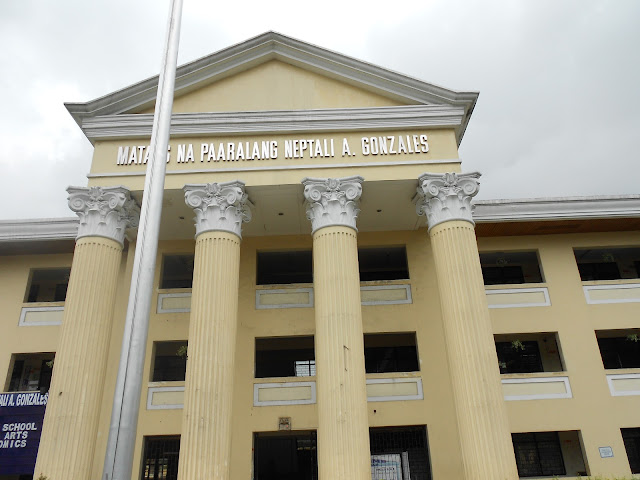During my week in Manila, I visited two government schools
also in the district of Mandaluyong. The trip was kindly facilitated by
the Department of Education. Below I include some photos and
commentary from what we saw.
School number one was
actually an elementary school, and we only went
around briefly. We arrived after lunch in what was a very active school
break, with swarms of children playing around the halls and courtyard.
They were very intrigued to see who the guests were, talking with their
Principal.
 |
School Entrance.
|
 |
| Elementary school - playground and classroom blocks |
 |
| Classroom block - no running in the corridors! |
 |
| A rather happy student, pleased with sliding down the bannisters and having his photo taken. |
 |
| District officer in charge of cluster of Mandaluyong public schools. Kindly hosted us around the school tours. |
The
second school we saw was a Senior High school, and is I believe the
flagship school within the District (it should be noted therefore that
it may not be completely representative of what other urban state
secondaries look like, for purposes of comparison to the private
school). We first met with the Principal and she then invited what I think must have been the entire female faculty to join us, as you can see from the photo below:
 |
Yours truly with staff of Gonzales High School. Principal is the lady immediately left of me.
|
When quizzed many of the staff had been
teaching at the school for between 7-15 years. All appeared very
pleased with their roles and the progress of the children (but then they
were all in front of their boss and conducting an official school tour,
so I'd hardly expect them to say anything else.)
The full name of the school is the rather lengthy Mataas
na Paaralang Neptali A. Gonzales, and you can visit the school's
official website
here.
From what I could gather, the late Mr. Gonzales Senior was a politician
representing the District in Congress, and he founded the original
school using his own money. His son, also now the current District
Congressman, is still sponsoring the school and has recently organised
and funded the construction of two new school blocks, adding 80 new
classrooms to the facilities.
Reminders of Messrs
Gonzales Senior and Junior were all over the school - both in the golden
statue greeting visitors in pride of place in the entrance courtyard,
and in the political banners hanging from the school blocks.
 |
Students just outside the Gonzales school entrance, leaving school after a busy day.
|
 |
University-esque facade that greets visitors upon entry.
|
 |
Statue of Congressman Gonzales, Snr, founder of the school.
|
 |
Dedication Plaque noting that the new Congressman Gonzales has organised the construction of the new school classrooms.
|
 |
Campaign poster for current congressman hanging in school.
|
As for the school's facilities
themselves, we unfortunately only got to see the empty classrooms. I
counted desks in each classroom, and they had been standardised to 45
students to 1 teacher, lower class sizes than typical for the private
school (and certainly for rural state schools). There didn't appear to
be any projectors or educational ICT equipment, but the new classrooms
were clean and spacious.
 |
Grade 7 weekly timetable - school day formally starts at 7am and finishes at 1.30pm.
|
One unexpected feature that the Congressman
had donated to the school was what was called a 'Practice House.' It
was essentially a stand-alone bungalow domestic residence, with
bathroom, living room, and kitchen, in which, so we were told, students
could practice 'home economics' and hospitality/domestic cleaning.
On
the one hand this is quite a practical policy to equip students with
vocational skills that are clearly in demand out there in the real
world. On the other hand, I worry that encouraging students immediately
into professional domestic service is perhaps reinforcing the
stereotypical role that foreigners often expect Filipinos to pursue. It
may not be raising aspiration in quite the best way, but we didn't
really have much of a chance to interrogate exactly how the Practice
House was used, which students got to use it, and how it integrated into
the standard curriculum.
 |
The outside of the Practice House
|
 |
The Principal shows us inside the Practice House.
|
 |
Another group photo outside the Practice House.
|
The school had decent sports facilities,
and was clearly relatively well-resourced. We couldn't get much detail
about the student attainment levels or extra-curricular activities, but
were reassured that relative to other government schools student
performance was strong.
 |
Gonzales Sports rink for basketball, football, and athletics.
|
In
terms of infrastructure the Gonzales school came across as marginally
better than the JRU private school. The comparison is interesting
though, because clearly Gonzales receives considerable formal and
informal funding subsidies to help it expand and maintain its good
quality infrastructure - I wonder how sustainable those levels of
subsidies will be right across the state system, particularly in the
poorer rural Provinces? Much more detailed data will be needed about
the inspection reports on each school, the assessment of student
performance, parental satisfaction levels, alumni tracking, College and
University acceptance rates, and indeed the actual nature of the
curriculum and student competencies mastered. It turns out that not
much standardised testing is actually done in the Philippines, and
therefore making precisely this quality comparison between private
schools and public schools is difficult. I think the last comparable
student performance data available that takes in both types of schools
is the 2002 PISA test, but I will have to dig into this.


















No comments:
Post a Comment